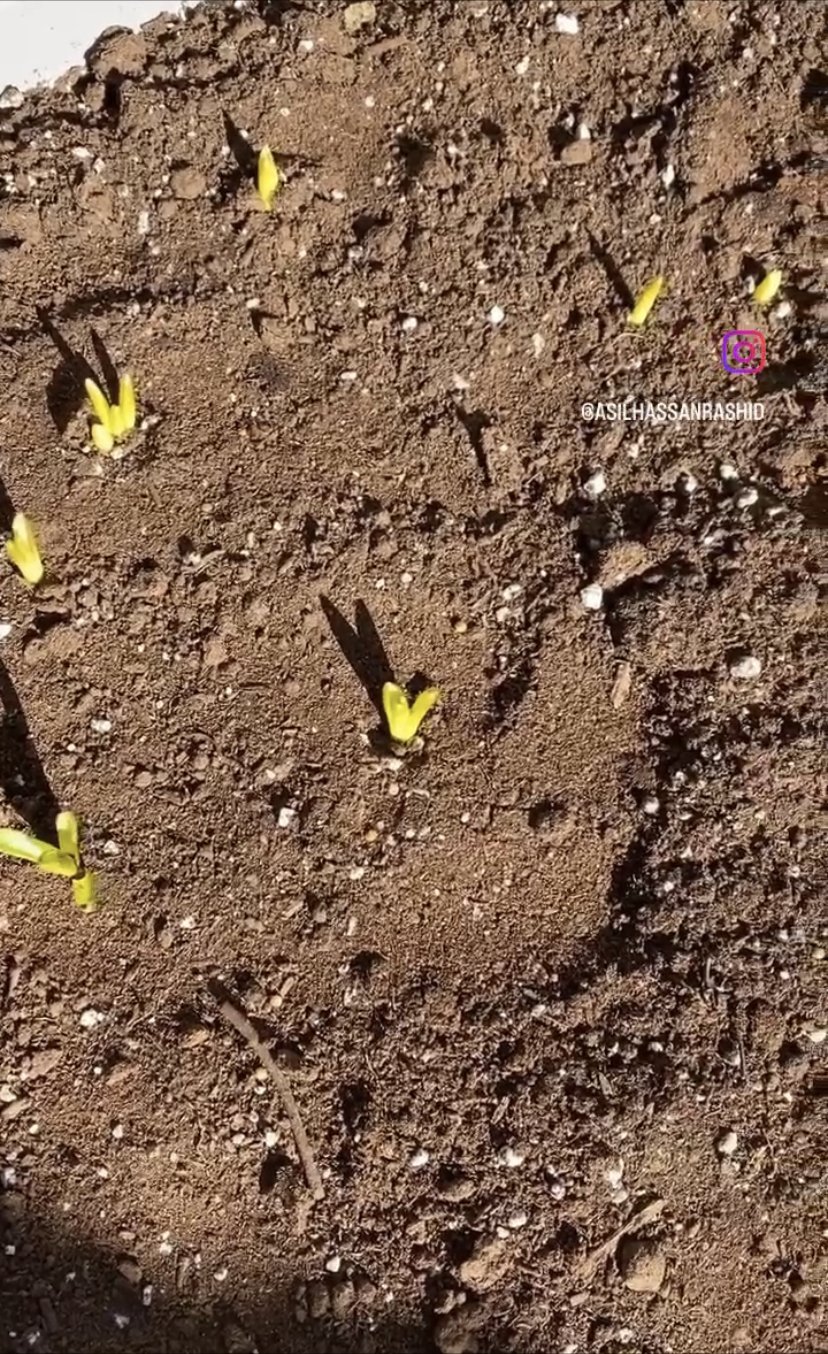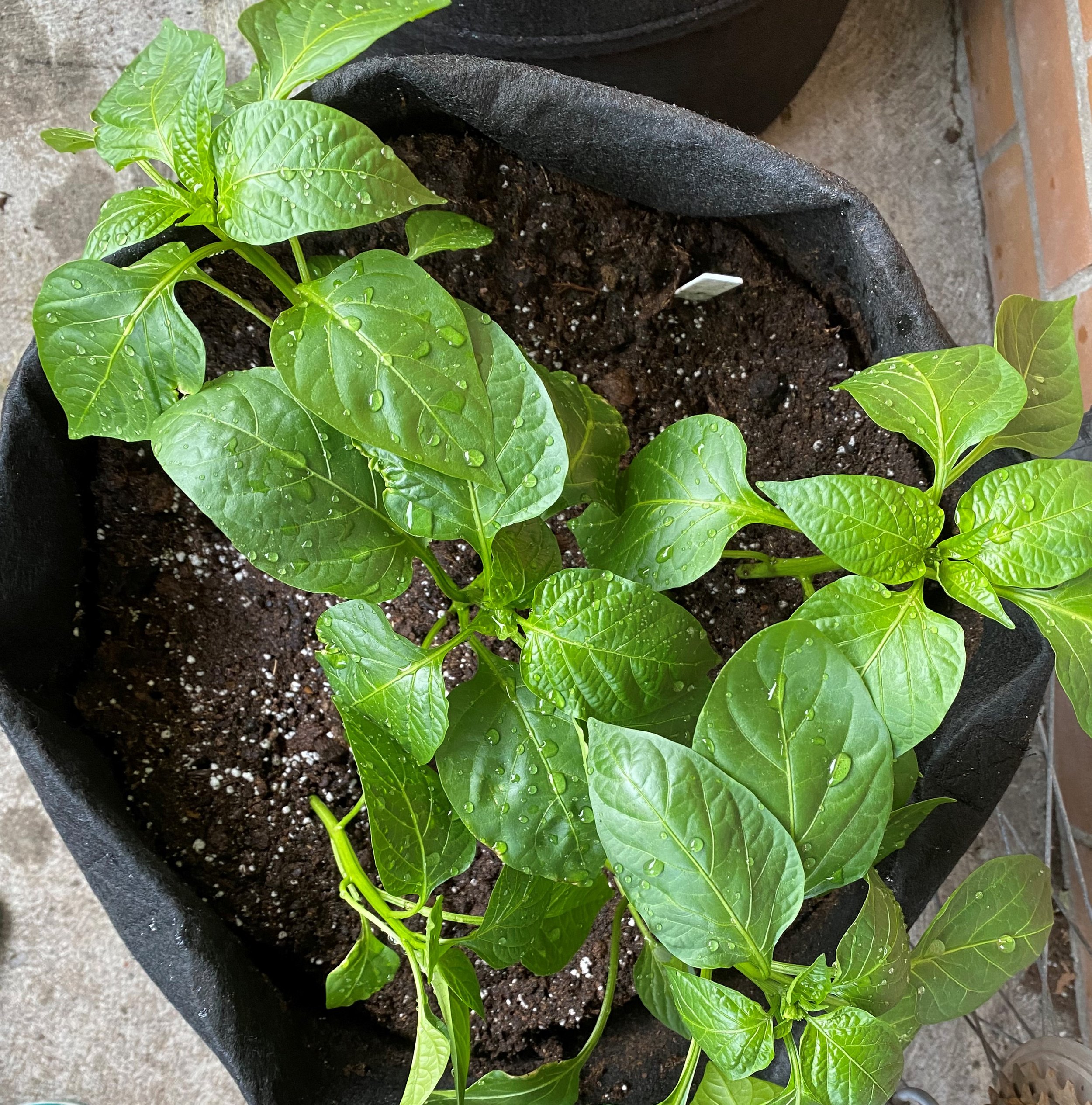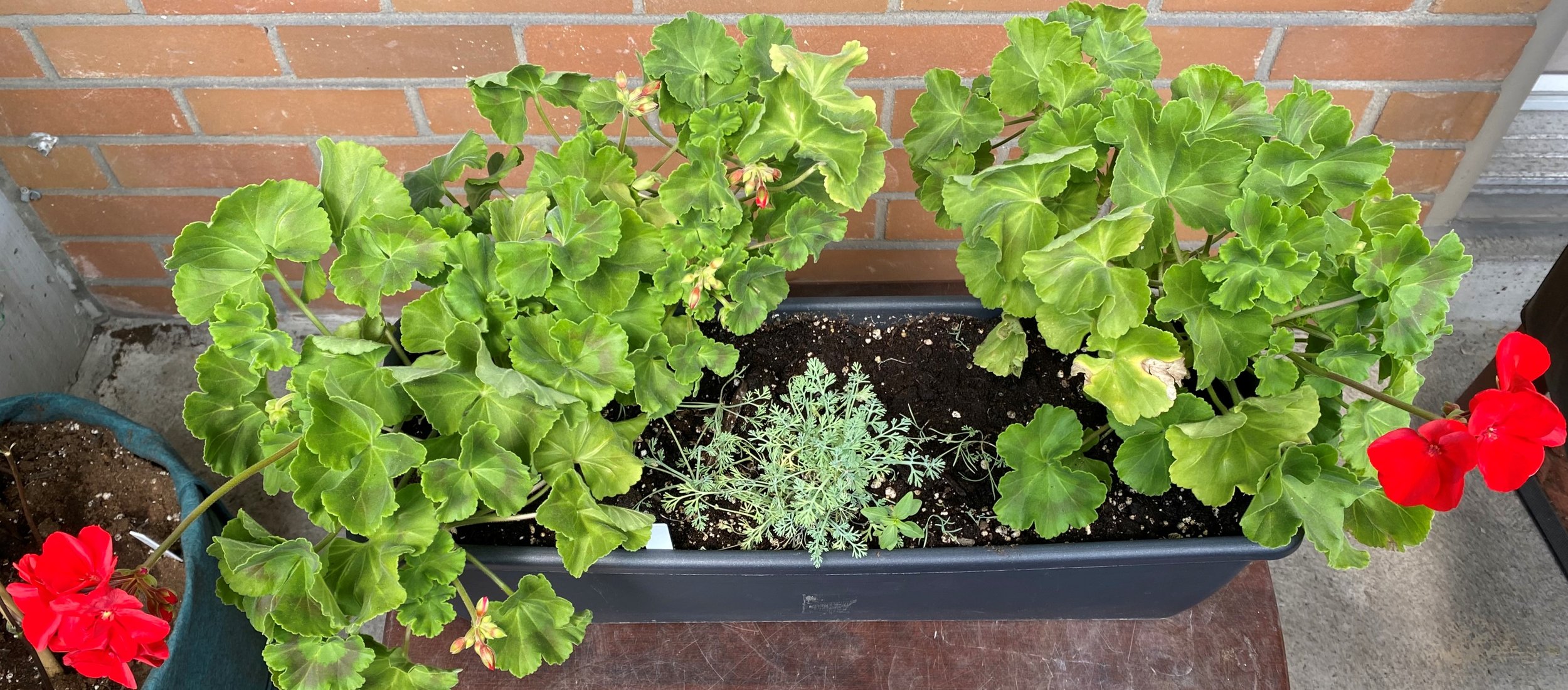Balcony garden 2023
Originally published May 29, 2023
As I said in my previous post, it's been a long winter and unpredictable spring, which meant the winter blues set in and triggered a seed sowing frenzy towards late February and early March. Montreal is in a 5a plant hardiness zone with short growing season and while it is good to get a head start, end of February is still way too early to start planting. It is mid-May now and most of my plants have grown out of the seedling stage and established. Some have even flowered. But I have had a few casualties along the way. For the most part, I'm growing the usual suspects, with a few new additions like the dwarf sunflowers, the dahlias, and cilantro. First things first:
1- Spring bulbs: tulips, crocuses and hyacinths-: In late October 2022, I decided I wanted to try my hand at spring bulb planting in anticipation of the winter ahead and my winter blues. Spring bulbs are typically planted in the fall and need a cold spell to trigger the bulbs into hibernation and ultimately spring flowering mode. The idea is to plant them deep in the earth and even during harsh winters like ours the entire weight of the surrounding soil provides with enough insulation to keep them from freezing. I, on the other hand, decided to plant them in a large container around 20 inches wide and 35 inches deep, thinking that the sheer quantity of soil it would fill up such a large container would provide it with the required level of insulation- seeing as how I planned to leave it outside during the winter. I planted them in what is called a bulb lasagna: with tulips going in the first and deepest layer, then crocuses and then hyacinths. I gave it a good watering and left it alone for a while. Around mid-November, due to an unseasonably warm spell (in fact, it was the warmest November on record) , green shoots started to grow. I did some research and found that if left alone and as long as no flower blooming has occurred, then the upcoming cold weather would force them back into the soil until spring. The biggest mistake I made was to continue watering them every couple of weeks. Spring bulbs like a dry environment and too much overwatering can lead to rot. My frequent watering of the bulbs and the additional moisture they were exposed to from the excessive amount of snow we had this winter (it was only around early January that I covered the container to protect it from too much snow) effectively killed them off. The green shoots that had given me hope in the fall promptly turned yellow and started wilting. I waited until well into the spring (around mid-April) before I gave up all hope and decided to dig them out. Sure enough, every single bulb I had planted had rotted and gone mushy. However, I bought some tulips from my local garden center around the same time and after letting the flowers and leaves die back I dug up the bulbs and stored them. I will try planting them for next spring.
2- Morning glory - By end of February, I was developing a serious case of winter blues and after checking in on my spring bulbs a few times and seeing the yellowing, wilting leaves, I was starting to get the feeling that my bulb experiment was failing. So what do I do? I start planting morning glory...in February!!! I didn't get a decent amount of flowers of morning glory last year (probably because I planted them too late in the season, around June) so I thought let me get at least 4 months head start on them this year! Morning glory are fast growing vines that grow beautiful blue, purple and pink flowers that open and bloom whenever the sun hits them. Hence the name. I've written before about how it's sentimental plant for me as it is the first flower that bloomed in my garden in Egypt after my daughter was born. Since then it's become a staple in my garden every year. Anyways, morning glories like full sun, warmth, plenty of water, plenty of space in a deep container and a trellis or a structure to climb up on. They also like to be direct sown as they don't do well with transplanting. I being a semi-seasoned gardener, ignored almost all these edicts. I planted them in late February in a small seed starting tray, placed them on a window sill and over the next few weeks watched those trendrils grow and twine around themselves into an uncontrollable mess of vines because of course I didn't provide them with any vertical support. By the first week of April, I couldn't look at them anymore and decided to transplant them outside in the balcony. After spending almost an hour painstakingly untangling the vines I planted them into a grow bag and inserted bamboo canes as a support Like I said, it was a long winter that lingered into spring, and these little buggers don't like being moved around too much. A few weeks of fluctuating temperatures caused them to die back one by one. A couple of weeks ago, I did a second sowing of morning glory and May weather being a bit more stable than April, most of them have germinated and slowly but surely growing. I'm hoping as we inch closer to June and the progressively warming weather will speed up the growing stage and I will have flowers by mid-July.
3- Carrots- This marks my third year attempting to grow carrots and I'm praying that the third time's a charm. Carrots are notoriously difficult to grow and being root vegetables they can only be direct sown in their final location. If not grown in the ground, then a deep container (at least 16 inches deep) or a grow bag would be ideal. Their germination is slow at best and can be very spotty. To speed up the germination process, I pre-sprouted the seeds in early March using the damp paper towel method (where I placed the seeds between two pieces of paper towels and sprayed it with water and then placed it inside a ziplock bag to create a greenhouse effect). Within a few days, the seeds opened up and little white shoots started growing out of them. The trick is to plant them outside before there are any green shoots. Of course I waited at east 2 weeks when almost all the seeds have grown green shoots, and of course I planted them outside in late March on the windiest day ever. Anyways, the seeds established, sort of, but I still had to do a second and third sowing. Now the carrot tops have grown a second and third set of leaves and they are way overdue for thinning. So I'm hoping once I've thinned out the leaves (carrots need a lot of space under the soil to grow long and semi-straight), and seeing as how I planted them in a deep grow bag, that I will have a better harvest this year than I did the last couple of years. Fingers crossed!
4- Basil - I sowed basil seeds in early March in a seed-starting tray (like most of my plants), which I would place on a sunny windowsill during the day and under grow lights at night. I waited until the 5 or 6 set of leaves started growing and the plant was fully established before moving it outside to the balcony. Ws still have a couple of cold nights coming up but all risk of frost is over.
5- Cilantro - This is a new one for me. I started them around the same time using the same methods as all the the plants (seed starting try and potting mix, direct sunlight during the day and grow lights at night). It has a slow germination period and does not like transplanting. After around a month in the tray I moved it into a bigger pot, hardened it off as the weather got warmer and now it's been on my balcony for the last 3 weeks and it is thriving. I'm going to wait a couple of more weeks before I start harvesting.
6- Parsley - Same sowing time and method as the other plants. The seedlings were a bit leggy when I transplanted them and they still look a bit leggy almost a month later, but they are starting to bush out with more leaves per stalk.
8- Kale- My star plant. Even though, I am often at a loss as to how to use kale in the kitchen (I've settled for kale chips which my daughter loves), I love growing it because it is very cold hardy. In fact, some people reported a sweetness to their kale leaves after a cold spell. I'm giving it a few more days to get bigger and then I will start harvesting.
9- Spinach- I skipped spinach last year as I did not have much success with it before. But being a cold-hardy plant I started sowing spinach around March. Once the seedlings got going, I transplanted them outside. The problem is spinach is very susceptible to bolting if the weather gets even a little bit warm, which is exactly what happened to most of my seedlings. Small flower heads started to appear, I've pinched some of them off and I did a second sowing. I will wait and see what happens.
10- Tomatoes, carnival peppers and cucumbers - Those are my warm weather plants. I started the tomatoes and carnival peppers in the same seed starting tray and potting mix as the herbs and leafy greens. Once they grew out of the seedling stage and became a bit more substantial, I transplanted them into slightly larger pots. A few days ago, I transplanted the tomatoes and cucumber plants again in the large container that I had previously used for my failed spring bulb planting experiment. The four cucumber plants are planted in the center and staked, with the yellow flowers already blooming (which is the first sign that actual cucumbers will develop soon) and the tomato plants are planted around them in the perimeter. The carnival peppers have been transplanted in a grow bag.
11- Scarlet runner beans - I started these in mid April in small pots. As usual, I was bit too eager. Runner beans, like morning glory, are fast growing vines and need sun, warmth and something to climb up on. Around early May I moved them outside into a grow bag and trained their vines along a net I hung up on the wall. Despite a freak frost event in the first week of May, they are thriving and still climbing upwards. However, time will tell whether the frost killed off any chance of flowers this season.
12 - Geraniums and California poppies- The geranium is the only plant that I haven't started from seed. It is last year's plant that I've overwintered indoors. Geraniums typically like to be pot bound and thirsted out, which is why, in an attempt at companion planting, I sowed California poppy seeds in the same container. California poppies also like a dry environment and nutrient poor soil. While my geraniums have started flowering already, my California poppy still has a ways to go, which is understandable given that I've sown them in a container with an already established plant. I've noticed that some of the leaves on my poppies are wilting and dying off, perhaps due to the fact that I fertilized the geraniums before I planted the poppies. But then again, it could be any number of things.
13 - Cosmos and dwarf sunflowers - my Cosmos is a repeat from last year. However, when I sowed them this year, I completely forgot that the reason I barely had any flowers last year is because the plant had fusarium wilt, a disease that starts from the roots, travels up the stem turning it brown and causing the leaves to shrivel and die. There is no cure and the only way to get rid of it is to throw out the plant, the container and the soil. Now I'm not sure if I just bought a bad set of seeds, but I am noticing troubling signs on my cosmos leaves. Again I will give it a few more weeks before I make a decision. Having completely forgotten about the fusarium wilt, I did the whole companion planting thing again and transplanted my dwarf sunflower plant (which already has 3 flower blooms) into the same flower box as my cosmos. While the flowers are still blooming the leaves on the sunflowers are developing grey spots. I'm not sure if this is a sign of the fusarium wilt from the cosmos or if this is just the leaves dying off before new blooms appear. I will just have to wait and see.
14- Sweet peas- Another year, another attempt at sweet peas. I sowed them in early March in upcycled yogurt containers because they like a little depth in their roots. They were doing well for a while and I even pinched them off. However, I transplanted them outside in April and I might have manhandled them a little as the roots were all tangled up. They are not looking particularly well at the moment, but I gave them some fertilizer at the time of transplant and added stakes and tied them with some jute string to train them along. I'm waiting for the warmer weather to roll around but I'm also not holding my breath for scented flowers this year.
15- Last but not least, dahlias!!! This plant is a monster! While no flowers have bloomed yet, the plant itself is now more than 30 inches tall. Seeing as how I planted the bulb in early April, this is an incredibly fast growth rate and it's reached the top of the bamboo cane I staked into it. It is the only plant left that is still inside the house. I take it out on warm days to harden off but will not let it sleep outside until June when nighttime temperatures will be consistently in the teens Celsius. Bloom time of flowers will be around mid June, hopefully. I will definitely keep you updated.
So far, so good for Mid-May balcony garden. I will be posting updates during the summer so stay tuned!

















